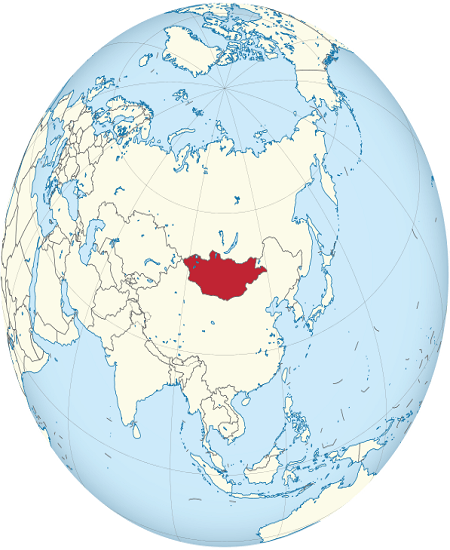A Viewpoint on Mongolia’s Position Between Russia and China
By Yehna Bendul, Research Staff Assistant, Sigur Center for Asian Studies
While discussions about Russia and China are increasingly pervasive in international affairs, Mongolia is often overlooked despite its unique geographic positioning between the two powers. On November 12, the Sigur Center hosted Ambassador Extraordinary and Plenipotentiary Otgonbaya Yondon of Mongolia to the United States for a seminar titled “Mongolia’s Position Between Two Global Powers, Russia and China.” With his extensive experience in both Mongolia’s Ministry of Foreign Affairs and the Mongolian People’s Revolutionary Party, Ambassador Otgonbaya provided many historical and contemporary insights into the Mongolian perspective. While valuable in their own right, these insights also provide a platform to examine current events in the region.
Ambassador Otgonbaya stressed that an understanding of the historical relationships between Mongolia, China, and Russia is critical to grasping the current geopolitical landscape. At the origin of these relationships is the Mongol Empire. While often depicted as a bloodthirsty regime, Ambassador Otgonbaya explained that it made numerous contributions to the modern world. For example, he noted that Mongolian invasions were a key impetus for unified Chinese and Russian identities. Low tax rates and protection of the Silk Road caused economic growth and prosperous trade of goods and information. Moreover, the Mongols introduced economic and political systems to the two countries that are evident in the etymology of the Russian and Chinese words for treasury, profit, money, and others. Thus in many ways, Russia and China’s paths to global power were paved by the Mongolians.
However, after the collapse of the Mongol Empire, the roles reversed and asserting sovereignty became a central and constant issue for Mongolia as it fell under the rule of China’s Qing Dynasty. Mongolia’s geographic position became a critical part of its fight for independence, as Russia only decided to support Mongolian autonomy to the extent that it would serve as a buffer zone from Japan and China. According to Ambassador Otgonbaya, this was so much a priority that Russia often referred to Mongolia as a nation whose territory was more important than its population.
Mongolia’s precarious location also influenced major decisions about domestic politics throughout history. For example, Ambassador Otgonbaya posited that the establishment of a communist government was not so much an ideological choice as an existential necessity. Similarly, Ambassador Otgonbaya adds that the 1990 Democratic Revolution in Mongolia can be viewed as a move to resist Soviet influence and solidify independence.
Important foreign policies have also risen as a result of Mongolia’s sandwiched location. The principal one is Mongolia’s Third Neighbor Policy which was practiced throughout the 1990s and formally articulated in the early 2000s. This policy essentially aims to establish relations with states other than Russia and China in order to decrease dependency on and limit influence from these two countries. Significance of the Third Neighbor Policy can be seen in Mongolia’s recent acceptance of an $85.6 million dollar loan from the Asian Development Bank (ADB) for renewable energy projects. That is to say, amidst China’s push for the Belt and Road Initiative, seeking developmental loans from a bank primarily financed by Japan and the United States clearly exemplifies Mongolia’s multi-pillared approach to foreign relations. Another and more explicit example of this policy is a trade bill introduced in the United States in July of 2018, titled the Mongolia Third Neighbor Trade Act, which aims to increase Mongolia-U.S. trade by reducing tariffs for various resources like textiles. Mongolia has also officially declared a policy of equidistance between Russia and China, meaning it pursues comprehensive economic and political ties with both countries. Ambassador Otgonbaya explains that peaceful relations with both countries are paramount given how expensive and difficult it would be to secure two long land borders.
Whether these policies will be enough to maintain independence from global superpowers is still a major question according to Ambassador Otgonbaya. While on the one hand, he acknowledges that being positioned between China and Russia is in itself a security guarantee, he counters that this is only true insofar as the two countries themselves do not turn on Mongolia. The Ambassador adds that international norms are stronger now than before, meaning Russian or Chinese violations of Mongolian sovereignty would be met with scorn. However, he conceded that while the world may seem more cooperative now, he still thinks the world is operating in a zero sum game that leaves the question of Mongolia’s fate with no clear answer.
However, it seems that even more pressing than Russian and Chinese influence may actually be Mongolia’s own domestic situation. During the Q&A session of his talk, the Ambassador acknowledged rising economic inequality in Mongolia that is contributing to a growing feeling of social injustice. He claims that if this issue is not tackled soon, then there is “every possibility for authoritarian regression.” Contributing to this issue is a recent corruption scandal implicating several senior Mongolian government officials. According to reports from the South China Morning Post, parliamentarians have channeled more than $1 million in government money meant for small businesses to friends and family. While hundreds gathered to protest these officials and government corruption in front of the parliament building on November 14, many more are frustrated with the condition Mongolia’s domestic politics.
Consequently, looking to the state of international relations for answers about Mongolia’s future may be slightly premature as domestic stability is integral to Mongolia’s ability to handle two neighboring global powers. Regardless, Mongolia proves to be a fascinating and unique case study that should not be overlooked.
 Yehna Bendul is a sophomore in the Elliott School studying Philosophy and International Affairs with a concentration in international politics. She is currently studying Spanish but is also interested in U.S. relations with East Asia. In her position as Research Assistant with the Sigur Center, Yehna hopes to learn more about other regions of Asia and develop a more holistic understanding of the continent.
Yehna Bendul is a sophomore in the Elliott School studying Philosophy and International Affairs with a concentration in international politics. She is currently studying Spanish but is also interested in U.S. relations with East Asia. In her position as Research Assistant with the Sigur Center, Yehna hopes to learn more about other regions of Asia and develop a more holistic understanding of the continent.
Image: A map of the hemisphere centered on 104, 47, using an orthographic projection. 2014. Source


